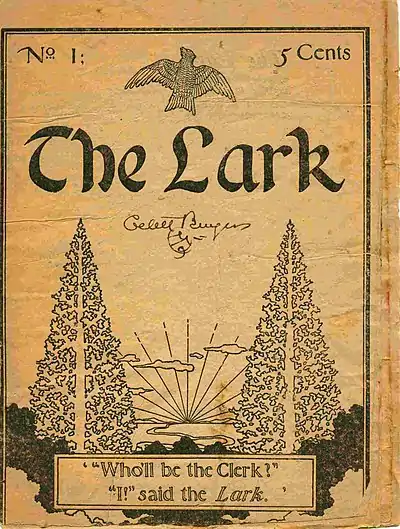
"Purple Cow" is a short nonsense poem by American writer Gelett Burgess. It was first published in 1895.
Poem
I never saw a Purple Cow,
I never hope to see one;
But I can tell you, anyhow,
I'd rather see than be one.[1]
Publication history

The poem was first published in the first issue of Burgess's magazine The Lark in May 1895 and became his most widely known work.[2] It originally had the longer title "The Purple Cow's projected feast/Reflections on a Mythic Beast/Who's Quite Remarkable, at Least".[3] This publication of the poem also included an illustration by Burgess featuring a cow jumping over an art nouveau fence heading towards a naked human, with both the cow and the human filled in black.[3] A poster version of his illustration is part of the collection of the Metropolitan Museum of Art.[4]
The poem became popular, eventually becoming what one commentator called "[t]he most quoted poem in twentieth-century America, after 'The Night Before Christmas'".[5] In addition to being widely anthologized,[2] it was often transmitted orally without credit to Burgess.[3] Many years after its appearance, publicist Jim Moran appeared at Burgess's home with a cow he had painted purple.[6]
Burgess came to resent its popularity. A few years after writing the poem, Burgess wrote another short poem in response, titled "Confession: and a Portrait Too, Upon a Background that I Rue", which appeared in the final issue of The Lark in April 1897:[7]
Ah, yes, I wrote the "Purple Cow"—
I'm Sorry, now, I wrote it;
But I can tell you Anyhow
I'll Kill you if you Quote it![8]
Afterlife of the poem
Several parodies of "The Purple Cow" have been written by others, including O. Henry.[6]
United States President Harry S. Truman was once asked by UFO researcher and publisher James W. Moseley if he'd ever seen a UFO. Truman reportedly responded by reciting lines from Burgess's poem. [9]
"Purple Cow" is also the name of the ice cream shop found inside Meijer stores. Founder Fred Meijer handed out cards for free ice cream at any Meijer Purple Cow ice cream shop to customers as part of a promotional campaign.[10][11]
The "Purple Cow Drive-In" ice-cream stand in Crimora, Virginia has a purple cow head on a post. Its status as a local landmark led to the naming of Purple Cow Road.[12]
Marketer Seth Godin has used the phrase "Purple Cow" for the concept of marketing a product as "intrinsically different" in his book, Purple Cow: Transform Your Business by Being Remarkable.[13][14] The phrase has also been used for the marketing concept of choosing a name which "makes your audience stop in their tracks and wonder why the title was chosen."[15]
A purple cow is the mascot of Williams College, a private liberal arts college in Williamstown, Massachusetts, which was named after the college's humor magazine Purple Cow, which, in turn, took its name from Burgess's poem.[16]
A slightly modified version of the final line of the poem is referenced in the book Fletch and the Man Who (1983) by Gregory Mcdonald in the line
"Irwin!" Roy Filby echoed. "I'd rather see one than be one!"
in which Filby is making fun of not only Fletch but his albatross of a first name, which is a recurring theme in the series of books.[17]
Purple Cow is a pipe tobacco blend manufactured by Cornell & Diehl blended by the late Bob Runowski and crafted for the Chicago Pipe Show years ago.
References
- ↑ "The Purple Cow". Poetry Archive. Retrieved 26 March 2013.
- 1 2 Richards, Rand (2002). Historic Walks in San Francisco: 18 Trails Through the City's Past. Heritage House Publishers. pp. 357–. ISBN 9781879367036. Retrieved June 8, 2014.
- 1 2 3 Gray, Janet (April 1, 2004). Race and Time: American Women's Poetics from Antislavery to Racial Modernity. University of Iowa Press. pp. 42–. ISBN 9781587294808. Retrieved June 8, 2014.
- ↑ American Art Posters of the 1890s in the Metropolitan Museum of Art, Including the Leonard A. Lauder Collection. Metropolitan Museum of Art. 1987. pp. 113–. ISBN 9780810918696.
- ↑ Silvey, Anita (1995). Children's Books and Their Creators. Houghton Mifflin Harcourt. pp. 103–. ISBN 9780395653807. Retrieved June 8, 2014.
- 1 2 Gardner, Martin (June 19, 2012). Best Remembered Poems. Courier Dover Publications. pp. 10–. ISBN 9780486116402. Retrieved June 8, 2014.
- ↑ Montanarelli, Lisa; Harrison, Ann (2005). Strange But True San Francisco: Tales of the City by the Bay. Globe Pequot. pp. 165–. ISBN 9780762736812. Retrieved June 8, 2014.
- ↑ Wilder, Marshall P., ed. (May 28, 2006). The Wit and Humor of America, Volume I. Infomotions.com. Archived from the original on February 17, 2012. Retrieved January 24, 2022.
- ↑ Shockingly Close to the Truth. Prometheus Books. 2002. p. 371. ISBN 1573929913.
- ↑ "Excerpts from 'Fred Meijer: Stories of His Life'". Mlive.com. 2019 [2009]. Retrieved January 24, 2022.
- ↑ Smith, Bill; Harmsel, Larry Ten (2009). Fred Meijer: Stories of His Life. Wm. B. Eerdmans Publishing. pp. 248–. ISBN 9780802864604. Retrieved November 28, 2014.
- ↑ "Dooms, Virginia: Purple Cow Head". Roadside America. Retrieved September 30, 2021.
- ↑ Godin, Seth (2003). Purple Cow: Transform Your Business by Being Remarkable. Portfolio. ISBN 9781591840213.
- ↑ Kuchner, Marc J. (November 15, 2011). Marketing for Scientists: How to Shine in Tough Times. Island Press. pp. 81–. ISBN 9781610911733. Retrieved June 8, 2014.
- ↑ Rogers, Scott (April 11, 2014). Level Up! The Guide to Great Video Game Design. Wiley. pp. 49–. ISBN 9781118877210. Retrieved June 8, 2014.
- ↑ "The Purple Cow Mascot". Williams College, Archives and Special Collections. Retrieved August 8, 2015.
- ↑ Aldrich, Chris. "Book Review: Fletch and the Man Who by Gregory Mcdonald". Retrieved November 26, 2016.